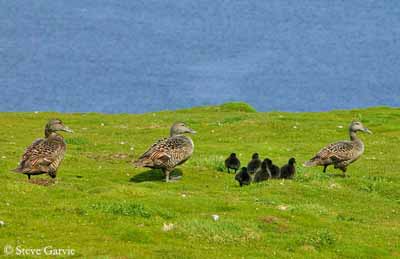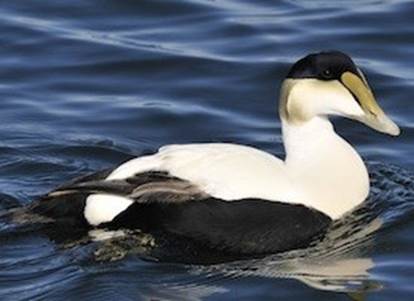And when at Night – Our good Day done –
I guard My Master’s Head –
‘Tis better than the Eider-Duck’s
Deep Pillow – to have shared
-My Life Had Stood a Loaded Gun – Emily Dickinson
This is a large and stocky duck found along the coastline of North America, Europe, and eastern Siberia – it is the largest duck in the Northern Hemisphere. In breeding plumage the male has highly contrasting colors of white, black and green while female is a dull brown for camouflage. These birds are 20 – 28 inches in length and weigh 41 – 107 ounces. It breeds in Arctic and some northern temperate regions and then winters along the coast below the Arctic when they form into large flocks. It is a bulky bird with a large wedge-shaped bill that is used to forage for crustaceans and mollusks on the sea floor, with mussels being a favored food. So get this – the eider east mussels by swallowing them whole and these are crushed in their gizzard while the shells are excreted. Eiders will eat crabs by tearing off their claws and legs and then swallowing them. One food habit study indicated that mussels represented 82% of the diet of common eiders – a substantial dependency on one food source.
Someteria – Latin, soma – body and erion-wool, and mollis – soft and issima – very; so basically a body covered in something very soft and wooly.
In 1961 Murro noted: A mass of eiderdown appears brownish-gray, flecked with white. It is marvelously light and soft, and is so compressible that the amount which can be wadded up in a man’s fist will, when released, expand to the size of a cantaloupe.
Eiders breed in colonies of between 100 and 10,000 individuals. Females display a high degree of natal philopatry – returning to the same island where they were hatched. It’s theorized that this is the reason that eiders have developed a kin-based social structure where there is cooperation among the breeders. Two to eight eggs are layered and incubated for about 25 days. Females will lay eggs in a relative’s nest and after hatching the young will for crèches – where females team up to share the work of raising the ducklings.
The ducklings fledge in two months. Eiders do not breed until they are three years old. Ravens and gulls are the primary predators on the eggs and nestlings. Eiders have shown a remarkable ability to return very close to their hatching location. On Cape Dorset 26 common eiders were banded in a population study in 1955. Ten years later, 25 of them were found in the same breeding area – 18 were within 50 feet of where they were originally banded and 7 others were within 200 feet of their banding sites. https://www.youtube.com/watch?v=C5bwpCLRQt8

The males do not hang around and depart shortly after the female begins to incubate the eggs, but they do have an interesting songhttp://ibc.lynxeds.com/sound/common-eider-somateria-mollissima/drake-calls
Females pluck their breast feathers and line the nest with eiderdown, which is the most prized down for insulation. Historically it has been harvested for quilt and pillow filling. Interestingly, eiders were one of the first species of birds protected in 676 in Northumberland, England by St. Cuthbert. About 1,000 birds still nest here and are often referred to as Cuddy’s ducks, vernacular for Cuthbert. More recently eiderdown has been replaced by goose down and synthetic fibers. They are still extensively hunted by Inuit People and eiderdown is still harvest commercially from nests, primarily in Iceland. http://eiderdown.com/http://icelandeider.is.w7.x.is/?page_id=2347
I was back east and at Acadia National Park in Maine last week and was lucky enough to see about 20 eiders along the coast. I haven’t seen these birds for 25 years and at first wasn’t sure what I was looking at – especially since they were all females. In the water they present a unique profile – head held high with a sloping face/bill. Once back in Seattle I looked them up and found out that once the males leave the nest they don’t associate with the females until later in the year. So what I was looking at was likely several adult females with a brood of juveniles – the males don’t get the more striking plumage until they are mature.
